 According to what i have eaten in the morning i am either a bit cynical about the real impact of activist projects or totally enthusiastic about their objectives and methods. Most of the time i am both. It also depends on the cleverness of the activists themselves. I still have to find any trace of ungainliness when it comes to The Institute for Applied Autonomy. The anonymous activist group believes in the importance of disseminating knowledge, encourages autonomy, and develops methods of self-determination through artistic expression and application of military-like technology to the topics of criminal mischief, decentralized systems and individual autonomy.
According to what i have eaten in the morning i am either a bit cynical about the real impact of activist projects or totally enthusiastic about their objectives and methods. Most of the time i am both. It also depends on the cleverness of the activists themselves. I still have to find any trace of ungainliness when it comes to The Institute for Applied Autonomy. The anonymous activist group believes in the importance of disseminating knowledge, encourages autonomy, and develops methods of self-determination through artistic expression and application of military-like technology to the topics of criminal mischief, decentralized systems and individual autonomy.
You might have read or seen one of their pamphlet-distributing or spray painting robots or participated to the protests during the 2004 US presidential campaign, by using their TXTmob system.
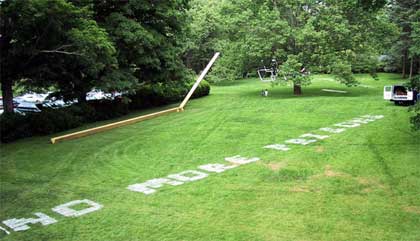 StreetWriter
StreetWriter
“The Institute for Applied Autonomy (IAA) was founded in 1998 as an anonymous collective of artists, activists, and engineers united by the cause of individual and collective self-determination.� Why did you decide to stay anonymous? How much does that anonymity serve your objectives? Is it part of a strategy?
Initially, we embraced anonymity as a defensive tactic, as many of our projects exist in a legal grey area. Working collectively and anonymously seemed natural to those of us with backgrounds in direct-action politics and the hacker and cypherpunks communities. Groups like Cult of the Dead Cow and native Hawaiian activists Hui Malama gave us a model for action that was both publicly engaged and effectively anonymous.
We’ve also found anonymity to be a useful tactic in dealing with the press. Many journalists seem to be more interested in writing about artists than about the art they create – this is particularly true when the work has explicitly political content. By refusing to provide any personal information about ourselves, we control the kinds of narratives that journalists create about our work and the issues it engages.
iSee enables users to avoid CCTV surveillance cameras. Some UK-based artists working on ideas of counter-surveillance for the broad public have discovered that in fact most people are totally comfortable with the idea of surveillance in public space. Have you noticed anything similar when you have deployed the project in several cities, both European and American? Did you notice different attitudes towards surveillance according to the country?
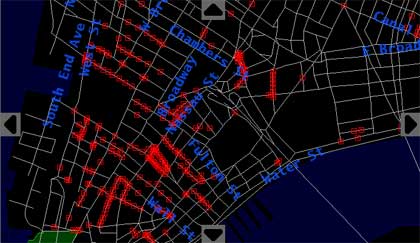
It’s true that many people are comfortable with surveillance of public space, especially when confronted with the usual choice between privacy and security. With iSee, we tried to subvert (or at least complicate) this binary. Initially this meant focusing on the mechanics of surveillance, pointing out that in practice CCTV surveillance has had very little impact on actual crime and that it is subject to the biases of system designers and operators, which means it often gets used to ogle women and single out youth and minorities for scrutiny. Ultimately though, the camera-avoidance part of the project became less significant than the data-collection and visualization aspects. We held workshops in which participants used our tools to create interactive maps of their city’s surveillance infrastructure. This activity asks a very different set of questions than simply “Does CCTV make you uncomfortable?� Instead, it points to the lack of any kind of baseline data about surveillance. Before we can have an intelligent conversation about CCTV surveillance, for example, it would be nice to know how many cameras are in operation, where they are, who owns them, etc. For the most part, this information simply doesn’t exist – In most countries, cameras are put up by individual building owners and their data is increasingly managed by third-party private companies. In effect, we have an emergent infrastructure of video surveillance that is growing on an ad-hoc basis, without any public discussion or oversight. The only way we have any information about the number and location of surveillance cameras is through the efforts of grassroots activists and concerned citizens.
Apart from surveillance and counter-surveillance, what are the issues you find worth fighting for/against?
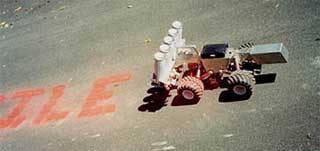 We’re generally interested in the intersection between technology, public policy and social control, and with building systems that facilitate freedom of speech and public acts of dissent. This encompasses a number of related issues including surveillance, public space, and law enforcement. We’re also extremely interested in the ways that technologies and scientific knowledge are produced, which has lead to an ongoing engagement with academic research labs and with the funding agencies that support them.
We’re generally interested in the intersection between technology, public policy and social control, and with building systems that facilitate freedom of speech and public acts of dissent. This encompasses a number of related issues including surveillance, public space, and law enforcement. We’re also extremely interested in the ways that technologies and scientific knowledge are produced, which has lead to an ongoing engagement with academic research labs and with the funding agencies that support them.
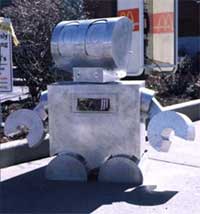 Your robots have a very peculiar look. Little Brother has a cute metal tin look, while the GraffitiWriter just looks efficient. What or who guides the way you design robots?
Your robots have a very peculiar look. Little Brother has a cute metal tin look, while the GraffitiWriter just looks efficient. What or who guides the way you design robots?
We employ what might be called a kind of “tactical aesthetics,� in which aesthetic decisions are determined by the intended goals of a particular project. Little Brother was intended to distribute subversive literature to unsuspecting audiences, so we tried to make him really cute and engaging.
GraffitiWriter on the other hand leveraged techno-fetishism to confer a kind of legitimacy to robot-mediated criminality, so it needed to look like a “cool� robot. While functionally similar to GraffitiWriter, Streetwriter was intended as a clandestine graffiti writing machine so it looks fairly innocuous, appearing to be an ordinary cargo van. The latest version of StreetWriter, which we call SWX, was intended for the very specific purpose of infiltrating the 2004 DARPA Grand Challenge which lead to a particular kind of sleekness in
the design, with a glossy white exterior and laser-cut aluminum logos.
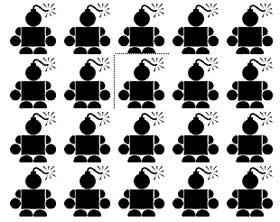 GraffitiWriter invites the public to spray paint graffiti on the pavement. How much are people ready to forget that they are well-behaved citizens and contribute to this piece of “street art� protest? Which kind of messages do you receive? Mainly love messages or rather angry complaints?
GraffitiWriter invites the public to spray paint graffiti on the pavement. How much are people ready to forget that they are well-behaved citizens and contribute to this piece of “street art� protest? Which kind of messages do you receive? Mainly love messages or rather angry complaints?
You’re referring to our “Rogues Gallery� project in which we took our GraffitiWriter robot to public spaces across the United States and Europe and offered it for use by the general public. One of the things that was so interesting about this project was that so many people were wiling to participate! We’d simply show up unannounced in a public park or city center, drive the robot around, and invite people to use the machine to spraypaint messages on the ground. Virtually everyone we encountered was willing to give it a try, even though what we were doing was clearly illegal. To us, this seemed to be an interesting inversion of the usual narratives about technology extending human abilities. With Rogues Gallery, the robot overcame certain kinds of social conditioning not because of its mechanical capabilities but simply because it was seen as legitimate, based on the assumption that anyone possessing a robot represented some large research institution which probably had the “right� to spray its messages on public space, rather than simply being a couple of crazy people who built a machine in their garage. Imagine if we had tried the same experiment without a robot, using only a few cans of spraypaint – no one would have participated because the action would have been clearly understood as an illegal act of public defacement.
What are the best locations to unleash a contestational robot?
It turns out you can release them almost anywhere. Although, I’d probably be careful around airports these days.
With the kind of public art/activist projects that you develop, things might not always go the way you foresaw. How much do you learn from the way users behave and interact with your pieces? Could you give (an) example(s) of unexpected and unwelcome/delightful experience?
Because our work mostly happens in uncontrolled environments, we’re almost always surprised by the way our projects unfold. The Rogues Gallery project we just discussed is a good example – our initial idea for the GraffitiWriter robot was to be able to spraypaint in places that are too dangerous for human activists, like banks, shopping malls, and government buildings. We had anticipated that if there were any problems with authority the robot would be sacrificed rather than the person. However, during its initial public deployment on the steps of the U.S. Capital Building, the robot and its human operators were detained by one of DC’s finest. Surprisingly, the presence of the high-tech looking robot confused what might have been a straight-forward arrest. At that point in 1999 it was unthinkable that juvenile delinquents would have a robot at their disposal. We probably fell between the categories of having to file a complicated report or needing to call for backup, so the officer let us go. In that moment we discovered that the robot functions best not as a covert writing machine but rather as a way to engage the public in participating in subversive activity using a powerfully legitimizing technology. There’s a bit of the Stanley Milgram experiment here, only using robots rather than lab coats as the symbol of legitimate authority.
Similarly, with TXTmob the SMS-broadcast tool we created for use by
protesters at the 2004 Democratic and Republican National Conventions, we found many examples of unexpected use. Because we worked closely with several activist groups to design the system, we had a pretty good idea of how it would be used by protesters. However, it quickly became clear that it was also a really important tool for journalists covering the protests. Because so many of the actions were spontaneous and short-lived, occurring all over the city (for example, groups of demonstrators mobbing convention delegates who were spotted eating at local restaurants), there was virtually no way for sympathetic journalists to know what was going on. Once the journalists started using the SMS system, however, they were able report on all kinds of sit-ins, street theater, and demonstrations. As a result, the quality of reportage for the Republican National Convention in New York was better than we’ve seen for most recent demonstrations in the United States.
Terminal Air is a visualization system developed for mapping the movements of planes used in the CIA extraordinary rendition program. How can the project help counter the extraordinary rendition program practice? Has anyone ever tried to silence the project?
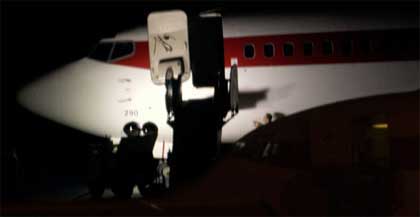
There are several components to the Terminal Air project. It is primarily an installation that examines the mechanics of extraordinary rendition, a current practice of the United States Central Intelligence Agency (CIA) in which suspected terrorists detained in Western countries are transported to so-called “black sites� for interrogation and torture. Based on extensive research, the installation imagines the CIA office through which the program is administered as a sort of travel agency coordinating complex networks of private contractors, leased equipment, and shell companies. Wall-mounted displays track the movements of aircraft involved in extraordinary rendition, while promotional posters identify the private contractors that supply equipment and personnel. Booking agents’ desks feature computers offering interactive animations that enable visitors to monitor air traffic and airport data from around the world, while office telephones provide real-time updates as new flight plans are registered with international aviation authorities.
Seemingly-discarded receipts, notes attached to computer monitors, and other ephemera provide additional detail including names of detainees and suspected CIA agents, dates of known renditions, and images of rendition aircraft.
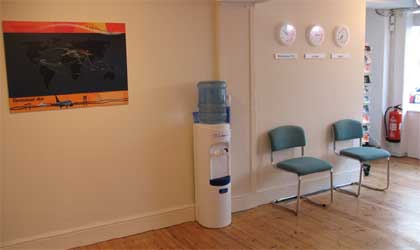
The project was inspired through conversations with extraordinary rendition researcher and author Trevor Paglen (Torture Taxi: On the Trail of the CIA’s Rendition Flights – Melville House Publishing). Data on the movements of the planes was compiled by Paglen, author Stephen Grey (Ghost Plane: The True Story of the CIA Torture Program – St.Martin’s Press) and an anonymous army of plane-spotting enthusiasts.
The main goal behind the Terminal Air project is simply to raise awareness about extraordinary rendition, to call particular attention to governments, airports, and private contractors who are complicit in its operation, and to recognize the ongoing efforts of various journalists, activists, and citizens who are continuing to uncover and document it.
We’ve also amassed a large database of flight log information, which we make available to the public. So far, no one has tried to interfere with the project (indeed, public reception has been quite positive), but it’s still in the early days – the first installation of the project was in March, and we anticipate a few high-profile shows this fall, so we’ll see what happens.
Any upcoming project you could share with us?
We’ve got a few things in the works, but generally prefer to announce projects after they launch rather than beforehand. We’ll let you know!
Thanks IAA!
